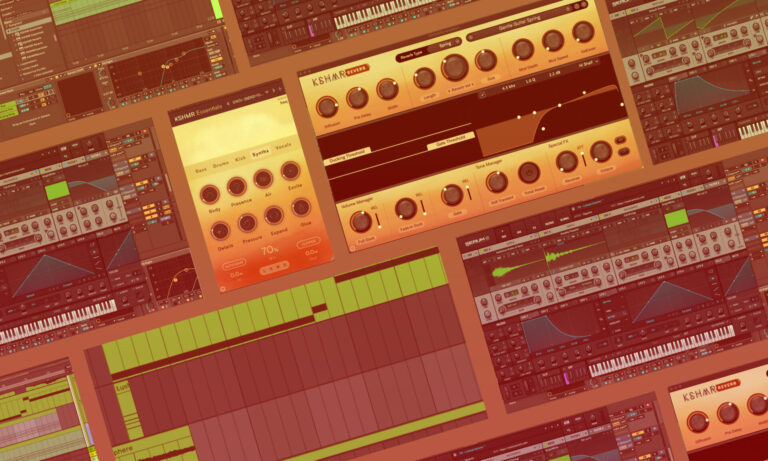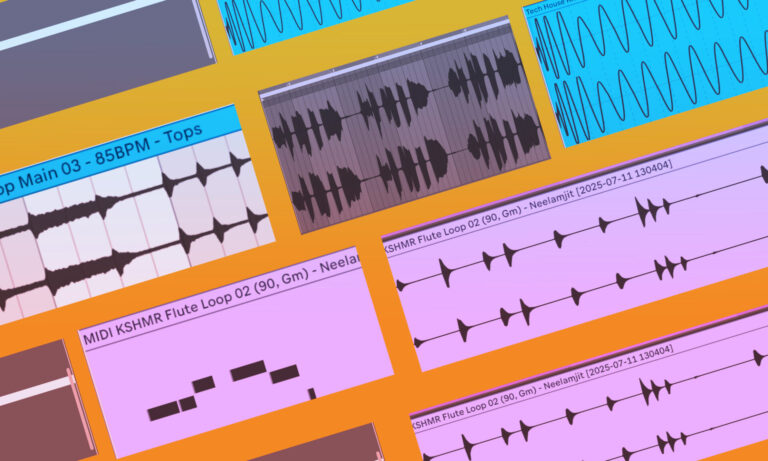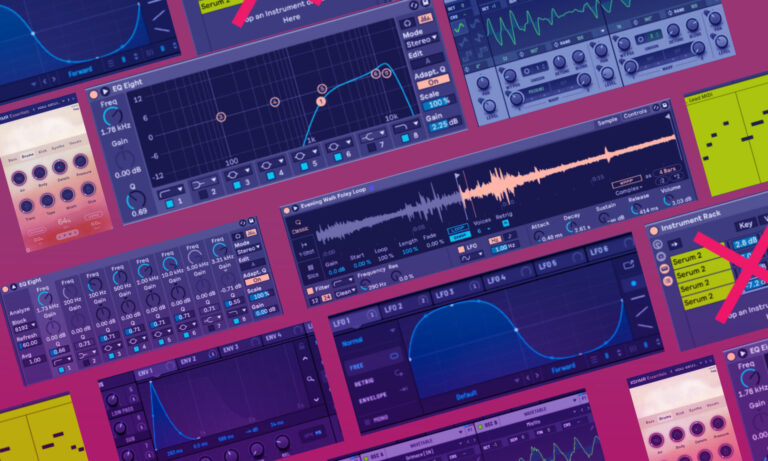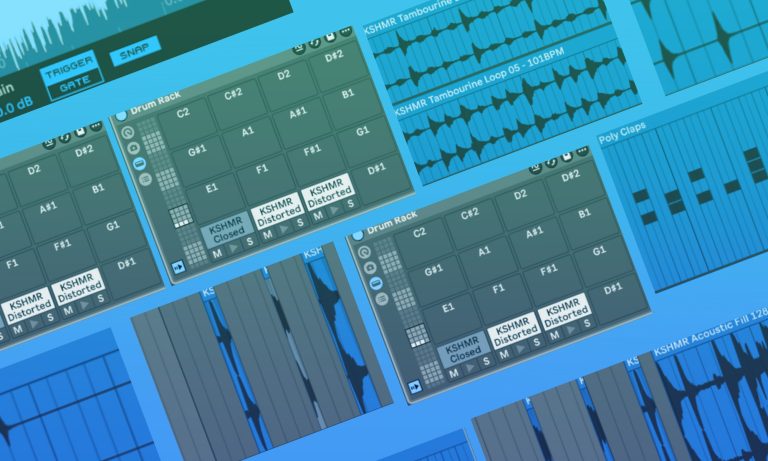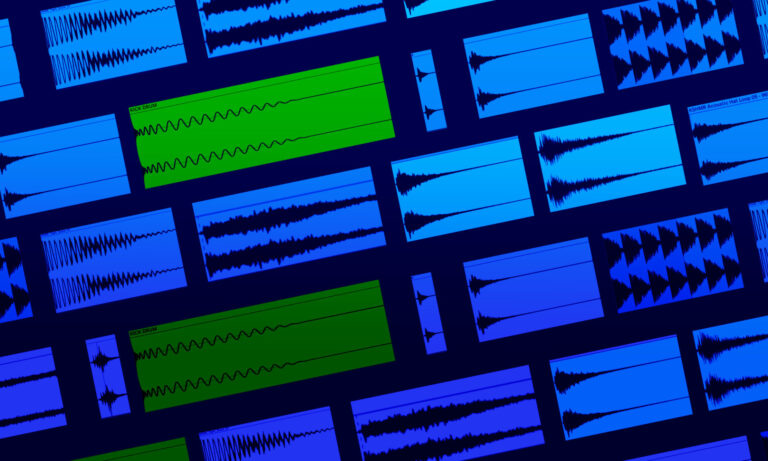- Start with sound, not theory
- Stick to one key and keep it simple
- Build melodies around rhythm, not pitch
- Use space to create phrasing
- Let modulation do the movement
- Keep percussion minimal and supportive
- Arrange in phases, not sections
Most melodic techno is based on a simple idea: melodic motifs repeated with purpose that move in interesting ways. But what makes it work is how it interacts with everything else— drums, bass stabs, and synth movement.
Melodies in this genre are less about harmony and more about timing, feel, and restraint.
That usually means leaving space, building tension with modulation, and letting your parts respond to each other across the arrangement.
Let’s learn how to build those melodies and keep them interesting without overdoing it.
1. Synth Patching and Sound Selection
Every producer attacks an empty project file differently. However, in melodic techno, a genre intentionally kept minimal, where the movement of the sounds used defines the entire groove of the track, starting with a sound is the best way to ensure the track has legs.

Diva delivers accurate analog modeling with flexible modulation for groove-focused melodic techno patches.
You’ll want to lean on analog-style synths here, like Diva or Arturia’s emulators and Serum 2 if you want more control. The key is to keep the oscillator section simple and focus on the filters and envelopes. Short attacks, quick decays, no sustains, and medium releases for any pluck-style leads help give you rhythm without sounds overlapping.

Serum offers some of the most finely-tuned modulation parameters in the game, along with FX and wavetables that can create unheard-of patches.
You can go slower for pads or longer tones, but keep it tight enough that it doesn’t smear across the groove. As with most energetic genres, the space and quiet between the hits add as much to the momentum of the track as the sounds themselves, and oftentimes sustained pads and held chords slow things down the second they’re introduced.
This can be effective for emotional moments in a track, but let’s not get ahead of ourselves too quickly; right now, energy is the main thing.

Ableton’s Configure tab can be a great way to save parameters you’ll want to modulate later; the ones that really make the patch come alive
Play with the decays, filters, and other on-board effects to see how expressive the sounds can be when pushed to their limits. The last thing you want is to write a track with something that sounds great, only to get to the final drop section and realize the synth has given you all that it has got and can’t be cranked up to 11 (That’s a Spinal Tap reference, for all you younger producers out there).
The goal is to make the patch feel like it’s breathing with the track, not fighting the groove.
2. Scales, Intervals, and the Root Note
The actual melody side of melodic techno is usually dead simple—and that’s intentional.

An Amin arpeggiator on dotted 1/16th notes lays a steady melodic base for the leads to contrast against.
Most of the time, everything’s grounded around a single scale or key, and it doesn’t shift. This simplicity reinforced the intended mood by locking it into one tonal center and using subtle movement to keep it alive.
Minor keys are the default, like the Amin arpeggiator in the image above. Dorian, Aeolian, and sometimes Phrygian are where more musically complex tracks sit, and even then, you’re not always outlining full scales.

For more interesting rhythms, turn off the grid and nudge notes manually until the groove feels right, then build in melodic movement. Those off-grid stutters so typical of the genre don’t need to come from LFO movement; sometimes it’s all in the MIDI!
A lot of leads are built entirely around the root note, maybe jumping up to the fifth or minor third once in a while. It’s more about rhythm, phrasing, and modulation than pitch and melodic variety. Single-note phrases are more straightforward to pitch and modulate with dystopian intensity in ways even two or three-note triads cannot.
And when harmony does show up, it’s usually implied through layering or voicing—pads that outline the chord, a sub that changes the chord’s root while the arp plays the other triad notes or a counter melody that fills in the gaps.
But even then, it’s sparse.
Again, the energy doesn’t come from harmonic movement. It comes from how those static notes are timed, filtered, and modulated.
If you find yourself stacking chords or building progressions, you’re probably leaning too far toward melodic house or cinematic techno. In this style, less harmonic information often leads to greater emotional clarity or intensity.
3. Melodies and Counter-Melody Interaction
Once you’ve dialed in your desired scale and sound, the next step is writing a simple melodic idea—something rhythmically interesting but harmonically minimal. Some of the lead melodies on the biggest releases on Afterlife consist of only four notes, played over eight bars. That simplicity gives them space to evolve and stay locked into the groove.
Not a solo.
Not a hook.
Just a very intentional loop.
It could land slightly behind the kick, or lines up tightly with the hats. Either way, it needs to drive the rhythm forward.

A syncopated pattern adds impact to the riff, while the space creates tension for a call-and-response effect.
Rhythmically interesting doesn’t mean complex. You’ll be adding movement later with modulation—if the rhythm is already dense, you’ll crowd out the pockets of syncopation that give melodic techno its edge.
This is where note timing, length, and swing matter almost more than the pitch of the note itself. Notice in the image below how the grid has been turned off and each note’s length has been manually adjusted? It takes some fine-tuning and a well-trained ear, but those small details are what can turn a good groove into a great one. It all comes down to paying attention to how the groove and the synth patch are working together and adjusting the MIDI accordingly.

The second part of the loop adds slight melodic variety while leaving its own space as well between the riffs.
A few well-placed notes can do more than a full melodic run, and it gives you something more valuable—space. A constant stream of notes might feel energetic, but it undercuts the syncopation between your synths and bass stabs. Leaving room between notes is what brings the groove to life.
It also sets up phrasing. When the melody hits and then steps out of the way, it opens a pocket for something else to respond—a counter-line, a secondary bass stab, or aggressive percussion.

The red MIDI is the heavily distorted bass line plucks that fill in the pockets of space created between the portions of the riffs!
Keep it rhythm-first. Lock it into the drums. Let it feel like part of the engine. Once it holds on its own, then you can build around it.
4. Modulation and Motion: How Movement Replaces Note Density
If the melody’s built around a simple melodic riff, it needs movement to stay alive.
That’s where modulation comes in.
Filter sweeps, pitch drift, amp changes—these keep a static pattern evolving without adding more notes. In melodic techno, that movement often carries more weight than the composition itself, especially in the first half of the track as the groove builds toward the breakdown and final drop.

Once you get the hang of using unsynced LFOs, they can become a magic bullet tool for intense, sweeping LFO moves that have become a staple of melodic techno lately.
LFOs do most of the work once the MIDI’s locked in.
Filter cutoff on a triangle wave, synced to 1/4 or 1/8, is a great starting point. Unsynced LFOs can push things further if you know what you’re doing, but can also get out of hand pretty quickly. Try routing a second one to pitch or detune for a bit of instability in the patch, then automate the envelope amount or resonance. A single sustained note can now move and breathe across a whole section.

Here’s that pocket-filling bass stab again—this time with velocity tweaks that can drive changes in distortion, filter cutoff, detune, or any other mapped parameter.
Velocity modulation is another easy win, especially on bass.
Since basslines remain simple to support more active synth rhythms and the movement of the lead synths, small velocity-based changes to the filter cutoff or resonance can help accentuate the groove and add variation without altering the notes.
This kind of modulation is what creates momentum.
Subtle shifts in tone and rhythm make the track feel like it’s progressing, even if nothing new has been added. That’s where the energy comes from. Before stacking layers, automate what’s already there.

Velocity-based modulation can be a great way to add minute levels of detail that make all the difference in making your track feel alive and expressive.
That’s usually where the best movement lives.
5. A Quick Note About The Complexity Of Your Drums
Once your melodic elements have movement and modulation dialed in, the next step is making sure they sit properly with the drums.
In melodic techno, percussion doesn’t lead the track as much as it supports it, as the drums act as a delivery device for the synth work (this isn’t true in every single track, but by and large it’s a good rule of thumb to lean on).
6. Arrangement Strategy
Once the groove is established and the melodic elements are locked in with the drums, the next step is determining when to bring everything together. One of the easiest ways to kill tension in a melodic techno track is by front-loading too many elements too early. If the full melodic structure is already in place by the first drop, there’s no room left to build.
Arrangement is easy once you know how, but if you second-guess your track-mapping chops, just start with a production template. They can be the secret sauce for mapping out your tracks quickly and professionally until you’ve built up the muscle memory yourself.
When in doubt, follow this simple gold standard of track arranging: start as simple as possible and don’t add any new layers until you feel you absolutely have to!
7. Workflow Tips and Final Thoughts
Finishing melodic ideas in this genre is more about discipline than inspiration.
Starting a loop is easy—making that loop carry an arrangement without getting distracted or adding ten extra layers is the real challenge. A few habits can make that process a lot more manageable.
Work in short loops and commit early. Eight bars max. Get the rhythm and melody tight but with enough nuance that it feels groovy and human, then duplicate it and shape the movement with automation—not more MIDI.
Don’t overcomplicate harmony.
If the root note feels right, let it stay. You can get all the movement you need from phrasing, filtering, and contrast. Background elements can hint at harmony without the lead having to spell it out.
And save your sketches. They might solve a future task in seconds, even if they don’t work today. Plus, the palette of sounds used in this genre isn’t that wide, and once you find a collection of 5-7 that work well together, you can usually write a few EPs worth of material with it.

